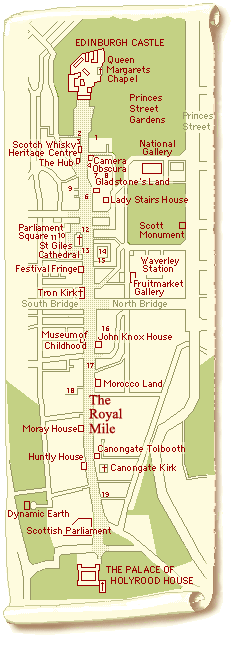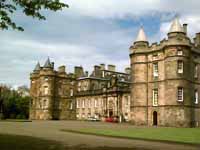Edinburgh's Royal Mile
Edinburgh's oldest street

"The largest, longest and finest street for Buildings and Number of Inhabitants, not only in Britain, but in the World..."
(Daniel Defoe, 1723)
Left;
The poet Alan Ramsay with Edinburgh Castle behind.
Probably Edinburgh's oldest street, The Royal Mile connects Edinburgh Castle (photograph above) with the Palace of Holyrood House.
Visitors will find a lot to explore on either side of this historic road;

Starting from the top,
EDINBURGH CASTLE,
(0pen April-Sept daily 9.30-6.00, Oct-March 9.30-5.00)
then. . .
Goose Pie House
Home of the 18th C poet, Alan Ramsey
Cannonball House
Late 16th C. A cannonball embedded in the walls marks the head height of the city's first piped water supply
Scotch Whisky Heritage Centre
(open daily 10.00-5.30)
The Hub
Festival Centre, Ticket office, etc (open daily 8.00-5.30)
Boswell's Court
Tenement built in c.1600
Camera Obscura and Outlook Tower
(Open April-Oct, Mon-Fri 9.30-6.00, Sat and Sun 10.00-6.00, Nov-March,10.00-5.00)
One of Edinburgh's top visitor attractions since the mid 1800's, with exhibitions of old photographs of Edinburgh, Holography and the Camara Obscura which reflects a panoramic view of the City onto a white table.
Originally this house was fitted up by Patrick Geddes in 1892 as "The nucleus of the University of the Future for all neo-technic thinking and teaching"
Assembly Hall
Site of the Annual General Assembly of the Church of Scotland.
Tollbooth Kirk
By Graham and Pugin (the latter, designer of the Houses of parliament in London) Now disused, there are plans to open this as a center for the Edinburgh Festival
Lawnmarket
Once a market place for linen.
Milne's Court
from 1690
James Close
from about the mid 1700's. James Boswell (writer) and David Hume (philosopher) lived here.
Gladstone's Land
(Open April-Oct Mon-Sat 10.00-5.00, Sun 2.00-5.00)
National Trust for Scotland 16th C house, restored and furnished to give the impression of life here in the 1600's. Decorated wooden cielings and 17th C painted wall friezes.
Lady Stair's House
(Open June-Sept, Mon-Sat 10.00-6.00, Oct-May Mon-Sat 10.00-5.00. Open on Sundays during the Festival, 2.00-5.00)
Built in 1662 and now the home of the Writers' Museum, with interesting relics and maunuscripts relating to Scotland's greatest literary figures - Robert burns, Sir Walter Scott and Robert Louis Stevenson
Brodie's Close
Named after William Brodie, a respectable member of 18th C society by day, but a burglar by night.
The High Kirk of St Giles
(Open Mon-Sat 9.00-5.00)
Later additions to the late medieval tower and "Burgh Kirk". From here John Knox preached and directed the Scottish reformation in the early 1500's.
Parliament Square
Law Courts
Built by Robert Reid (1776-1856) after designs by Robert Adam (1728-1792), architects who both embody the Age of Reason
Parliament House
1632-1640. Built for the Scottish Parliament and used until the Act of Union in 1707.
Monument to King Charles II
Erected in 1685
Heart of Midlothian
A heart set into the street cobble stones and marking the site of an ancient tollbooth.
Mercat cross
Traditionally from whence declarations were made to the townspeople
High Street
City Chambers
Designed by John Adam , brother of Robert
Mary King's Close
Closed after the plague of 1645, this building is sometimes open during the Festival (!). Contact the Tourist Information Centre for details
Anchor Close
Tron Kirk
Now the Old Town Information centre
(Open April-May, Thurs-Sun 10.00-5.00, June-Sept, daily, 10.00-7.00. Tel: 0131-20-1637)
Brass Rubbing Centre
(Open June-Sept, Mon-Sat10.00-6.00, Oct-May Mon-Sat 10.00-5.00, Open on Sundays only during the Festival, 2.00-5.00)
Surving remnant of the Collegiate Church founded in 1460 and now housing a collection of replicas of ancient Pictish Crosses and medieval brasswork from which you can take impressions on paper.
Museum of Childhood
(Open June-Sept, Mon-Sat10.00-6.00, Oct-May Mon-Sat 10.00-5.00, Open on Sundays only during the Festival, 2.00-5.00)
Historical toys, books, dolls, and much frequented by children.
Moubray House
Daniel Defoe's office, and thought to be the oldest surviving dwelling in the town, but unfortunately not open to the public

John Knox House
John Knox house
Devoted to the life and career of the Scottish religious reformer, this picturesque house has inscribed on the outside: "LYFE GOD ABUFE AL AND YI NYCHTBOUR AS YI SELF"
Canongate
Chessel's Court
Built in 1745 as mansion apartments

Looking up Canongate
Morocco Land
Restored early 18th C tenement which takes its name from a half length figure of a Moor on the front
Canongate Tollbooth
(Open June-Sept, Mon-Sat 10.00-6.00, Oct-May 10.00-5.00, and also, during the festival: Sun 2.00-5.00)
The tower was built in 1591. The building now houses a museum: "The Peoples' Story", everyday life of the inhabitants of Edinburgh down the centuries.Canongate Kirk
Built in 1688 after James VII had given orders for the Nave at Holyrood Abbey to be converted from the parish church to the chapel for the Order of the Thistle.

Canongate Kirk
Huntly House
(Open June-Sept, Mon-Sat 10.00-6.00, Oct-May 10.00-5.00, and also, during the festival: Sun 2.00-5.00)
Restored 16th C, and now contains a museum of local history, and also relics relating to Field Marshal Earl Haig.
Panmure House
Late 17th C house once belonging to Adam Smith, the famous theoretician of political economy.
New Scottish Parliament Building
Designed by Catalan architect Enrico Miralles, opened in 2005
Dynamic Earth
History and Geology interactive info-tainment for children and adults
Apr-Oct; 10.00 to 6.00,daily, Nov-Mar; 10.00 to 5.00, Wed-Sat.
White Horse Close
From an Inn on this site stagecoaches used to leave for London.
The Palace of Holyrood House
Legend has it that King David I, son of Malcolm Canmore and St Margaret, was hunting one day in 1128. His horse was startled by a stag which appeared from nowhere, and King David found himself hurled to the ground and in mortal danger of being gored by the stags antlers. In desperation he grasped hold of them whereupon they miraculously changed into a Crucifix. This story has echoes in the similar story of St Hubert in France. That night King David pledged to build an Abbey for Canons devoted to the Cross.
Holyrood means "Holy Cross"
By the early 1300's there was already a Royal Residence built adjacent
 to the Abbey Church. Now, the oldest part, on the left as you look at the entrance and front courtyard, was built in 1528-32 by John Ayton, master mason to James V. Later, in the 17th C, the present much extended form was created during rebuilding for Charles II.
to the Abbey Church. Now, the oldest part, on the left as you look at the entrance and front courtyard, was built in 1528-32 by John Ayton, master mason to James V. Later, in the 17th C, the present much extended form was created during rebuilding for Charles II.
Today the Palace is often used as a Royal Residence, and this means that it is sometimes closed to the public at irregular times. But if you do get a chance it is well worth visiting. The interior is fascinating, both the older Historical Apartments (where Mary Queen of Scots often stayed, and where her private secretary and confidant Rizzio was stabbed to death on instructions from her husband, Lord Darnley), and the State Apartments which are notable for their paintings, decoration, chimneypieces and plasterwork dating from between the 1600's and 1900's.
* Holyrood Palace is often closed for the royal visit in the middle of May and during the last two weeks of June and the first week of July. See Margot MacMurdo's Edinburgh Tour for up-to-date opening times.
Edinburgh Art Galleries...
National Gallery | Fruitmarket Gallery | Gallery of Modern Art |
Supporting pages about Edinburgh...
Brief History | The Royal Mile | Architects of the Enlightenment | Georgian New Town | Alice's Fringe | Arthur's Seat
